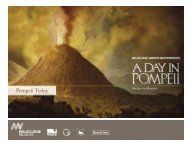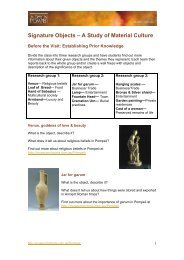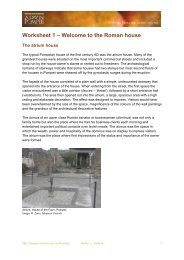Exhibition notes for A Day in Pompeii - Museum Victoria
Exhibition notes for A Day in Pompeii - Museum Victoria
Exhibition notes for A Day in Pompeii - Museum Victoria
You also want an ePaper? Increase the reach of your titles
YUMPU automatically turns print PDFs into web optimized ePapers that Google loves.
http://museumvictoria.com.au/<strong>Pompeii</strong><br />
<strong>Exhibition</strong> Notes<br />
MEDICINE<br />
Thoroughly modern medic<strong>in</strong>e<br />
The wealthier citizens of <strong>Pompeii</strong> had access to surpris<strong>in</strong>gly sophisticated medical care.<br />
In fact, the Romans had begun learn<strong>in</strong>g about medic<strong>in</strong>e centuries earlier, around the end<br />
of the third century BC, when the first Greek doctor came to Rome.<br />
At first, the ‘practice’ of medic<strong>in</strong>e was just that: methods were based on trial and error,<br />
and anyone could call himself a doctor. Many medical practitioners were slaves, and as<br />
a result the profession did not enjoy a high reputation. However, these experimental<br />
doctors’ methods improved over the years, as successful treatments were noted and<br />
passed on. Roman doctors began to study the works of Hippocrates (the Greek<br />
physician known as the ‘father of medic<strong>in</strong>e’) and by the time of Augustus the Romans<br />
were writ<strong>in</strong>g their own medical texts.<br />
Roman doctors used a great variety of medic<strong>in</strong>al plants, <strong>in</strong>clud<strong>in</strong>g morph<strong>in</strong>e extracted<br />
from opium poppies to take away pa<strong>in</strong>. They made prostheses to replace lost limbs, set<br />
broken bones and per<strong>for</strong>med many k<strong>in</strong>ds of surgery. One popular procedure was<br />
treph<strong>in</strong>ation – drill<strong>in</strong>g holes <strong>in</strong> the patient’s skull to relieve pressure. Even cosmetic<br />
surgery was per<strong>for</strong>med <strong>for</strong> the wealthy.<br />
Roman surgical <strong>in</strong>struments were strik<strong>in</strong>gly similar to modern ones, and used <strong>for</strong> many<br />
of the same purposes: steel or bronze scalpels to make <strong>in</strong>cisions, blunt hooks as probes<br />
<strong>for</strong> dissection, sharp hooks to lift pieces of tissue, <strong>for</strong>ceps to extract small pieces of<br />
bone, and bone saws <strong>for</strong> the heavy work of per<strong>for</strong>m<strong>in</strong>g amputations. These pioneer<strong>in</strong>g<br />
surgeons also used catheters to remove blockages <strong>in</strong> the ur<strong>in</strong>ary tract and bleed<strong>in</strong>g cups<br />
to remove blood <strong>in</strong> an attempt to rid the body of disease. An impressive set of 40<br />
surgical <strong>in</strong>struments was found <strong>in</strong> the aptly named House of the Surgeon at <strong>Pompeii</strong>.<br />
Although hygiene was improperly understood <strong>in</strong> Roman times, the extensive aqueduct<br />
systems delivered fresh water to millions and helped prevent water-borne diseases, as<br />
did the sophisticated toilet and sewerage systems which carried wastes away from<br />
densely populated areas. (Ironically, the lead pipes which carried the water posed their<br />
own health threat, a fact which was known to the Romans.) They may have had no cure<br />
<strong>for</strong> lead poison<strong>in</strong>g, but they were clearly aware that good food and exercise were<br />
important <strong>in</strong> ma<strong>in</strong>ta<strong>in</strong><strong>in</strong>g a healthy body. In fact, the Roman medical system was so<br />
advanced that it rema<strong>in</strong>ed unsurpassed until the n<strong>in</strong>teenth century, and the snake (the<br />
symbol of Aesculapius, the Greek god of medic<strong>in</strong>e) is associated with the medical<br />
profession to this day.<br />
RELIGION<br />
Cult follow<strong>in</strong>g: the importance of the gods <strong>in</strong> daily life<br />
The Pompeians worshipped many gods, primarily Graeco-Roman deities such as Jupiter<br />
(the Greek Zeus), Juno (Hera), M<strong>in</strong>erva (Athena) and Apollo. The oldest temple <strong>in</strong><br />
<strong>Pompeii</strong>, which dates to the sixth century BC, may have been a temple of M<strong>in</strong>erva. A<br />
temple of Apollo stands next to the Forum and a temple of Jupiter at its north end, both<br />
built <strong>in</strong> the second century BC. In about 80 BC, a temple of Venus was built on high<br />
ground <strong>in</strong> the southwest corner of the city overlook<strong>in</strong>g the sea, from which mythology<br />
tells us the goddess was born.<br />
7


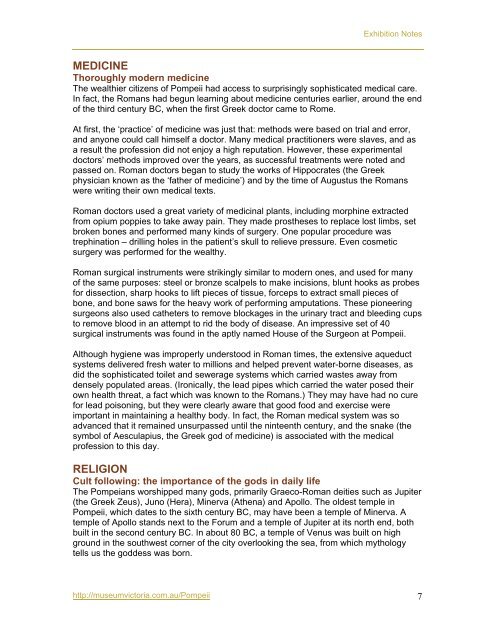



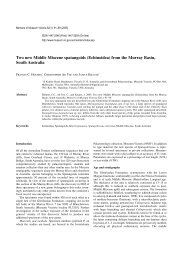
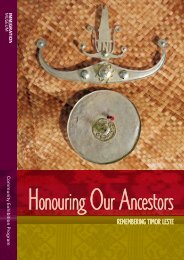
![[PDF] Andiamo a Pompei- Teacher Notes ... la - Museum Victoria](https://img.yumpu.com/16309810/1/190x245/pdf-andiamo-a-pompei-teacher-notes-la-museum-victoria.jpg?quality=85)

